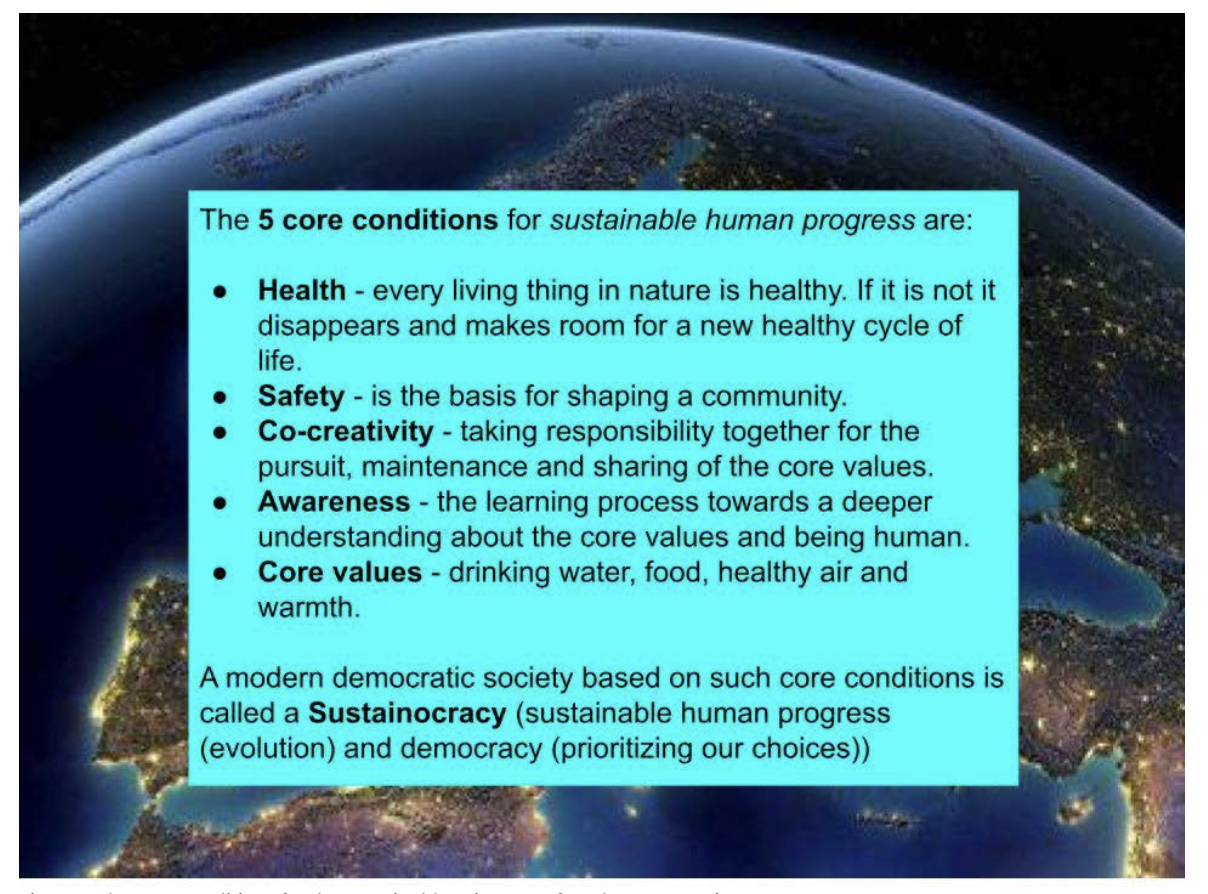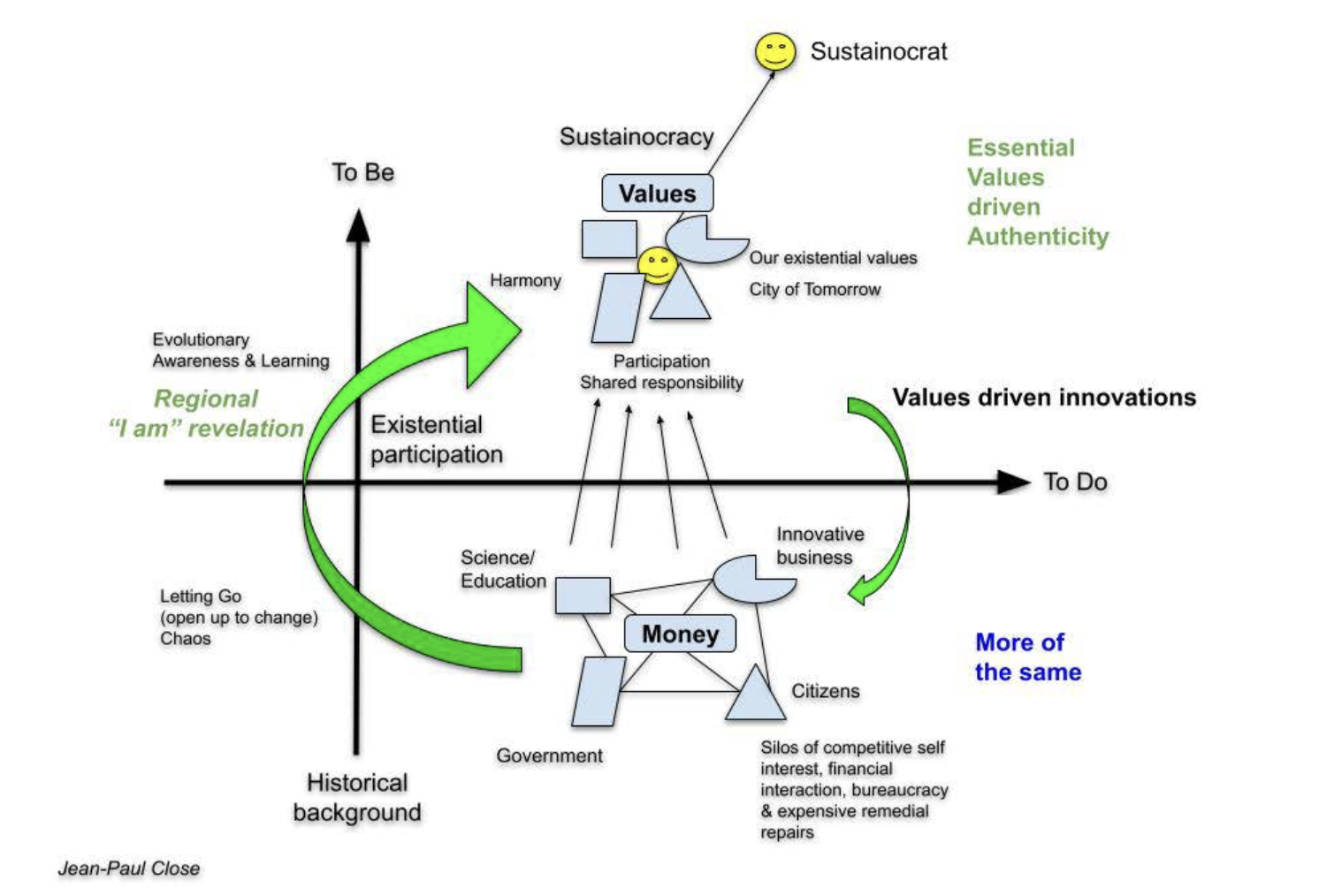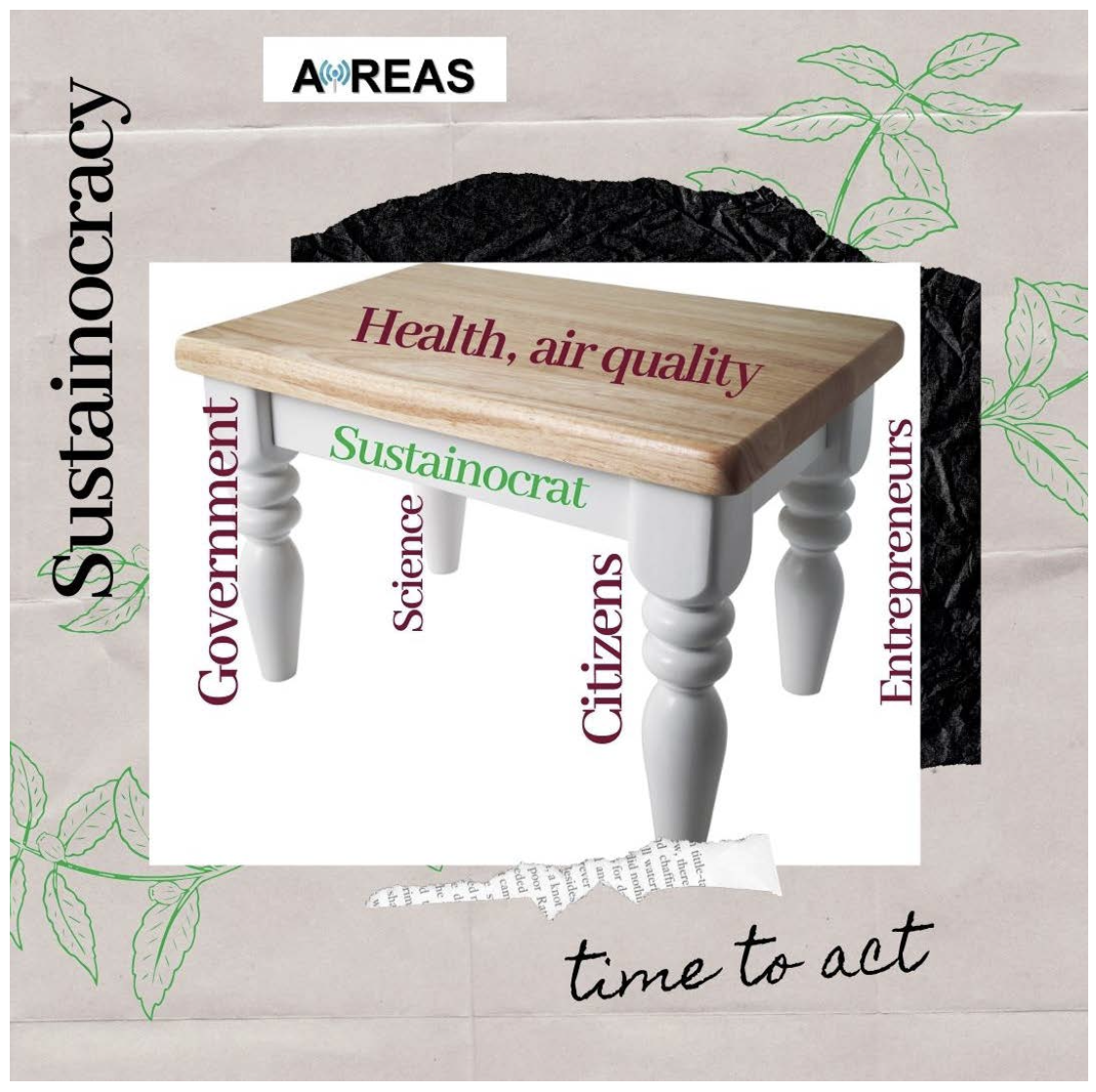Redefining regional existential authenticity and sustainability
In our current era we need to consider our “sustainable existence as a natural human species” when referring to the word “sustainability”. What does this mean for ourselves, our behavior, our relationship with money, our relationships in general, our functions in society, the way we shape our communities, institutions, cities and regions?
The small STIR (Sustainocratic Transformation, Indexation and Research) foundation in the Netherlands decided to address this fundamental question. During its research, the foundation was also challenged to put it into practice, engaging all others, people and institutions, into a new era of interaction for regional identity and sustainable development.
STIR defined five essential conditions (figure 1) for human existence, positioning them as a shared responsibility of all people and institutions alike. This approach arose from an existential question: “What are we?” and, more specifically, “With what objectives do we deploy ourselves and the different functions in society?”
This societal commitment, from a natural human existential point of view, was coined a Sustainocracy (sustainable human development through a real-time democracy of shared responsibilities) in order to differentiate from any other societal approach or discussion about sustainability.
Gradually a new societal narrative appeared that involved all local stakeholders and leadership archetypes. A narrative that would redefine the local existential values driven identity and attractiveness of the region with the involvement of all people and institutions together.

Our own regional 4 x WIN Sustainocracy
For a long time humankind has been governed through dependence on money and an economy of growth as a sole measure for success. This bubble of thinking burst largely in 2008 when the global banking crisis disrupted the trust in money. Money, together with the already fragmented, dominant, manipulative, often corrupt and competitive human desires for power, ownership and control, has haunted humankind ever since we learned to say “this is mine”. This egocentric, immature attitude took our attention away from our existential human essentials, replacing them with short-term, competitive (self)interests, fragmented tunnel visions and blind, unnecessary survival mechanisms.
Meanwhile, in a relatively short time, the numeric presence of humankind worldwide exploded from less than 1 billion to over 8 billion souls. Despite our scientific and technological advances our current global human presence is referred to as the “sixth cause of mass extinction”. Taking responsibility for our sustainable existence seems to correspond better with our self-image of an intelligent and dominant species than accumulating money at the expense of everything.
But how?
While looking at this fairly common operational picture (figure 2) from a natural existentialist helicopter view, we can ask ourselves, “who is responsible for our sustainable human existence?”. In this overarching reality, the diversity of institutions tends to lead their own economic development, influencing each other to sustain themselves in a financial world. Citizens interact through labour and consumption, demanding at times attention for their human rights in an institutionalized network where the human being is just a replaceable means. Existential problems are addressed remedially as a cost, a choice, putting more pressure on the political and financial systems and the human resilience potential. When, in this societal configuration, we wish to attend to the existential human perspective, who should we address?

It is easy to conclude that none of the silos will be able to take that existential human responsibility by itself. The only democratic way to make it happen is to involve all, by addressing it as a challenging opportunity.
STIR decided to position itself outside the blinding, competitive, financial environment at a point of existential human sustainability. From this point, it called out to the different players within society to come and develop that sustainability together. It did not value the potential participants for their competitive and fragmented financial self-interest. It valued them for their potential contributive possibilities in regional existential, innovative, natural human development.
At the regional level it demanded all relevant members of the community (and the community itself) to decide “what are we?”. This existential question had preceded STIR in the city of Eindhoven already in the late 90’s. The city had been forced to redefine itself when leading and impactful local industrial institutions decided to relocate to low-wage regions.
STIR added the human centered approach and complexity to it.
Converging into a multidisciplinary environment of shared existential responsibility, the STIR societal design table potentially helps streamline society through multiple innovative cross-overs. A leading politician exclaimed when participating, “Here we solve issues in half a day, when in government we take 30 years!” This remark also indicates that the traditional politically driven environment is not the place for existential processes. It needs to be leveraged to the level of shared responsibility, with the government as one of the contributing pillars, not the only one. And certainly not in a leading role when driven by contradicting political and financial interests.
The opportunity to join a values-driven cocreation environment, in which their institutional, contributive authenticity prevails over their competitiveness, is sensed as a welcome open space for innovation, worth investing in and reaping its benefits (Figure 3).
Institutional or personal self-interest, combined with a common purpose and existential objective, delivers a positive, regenerative spiral for all involved. Any fragmented, material and immaterial values that are produced in the cocreation arena flow back to the diversity of institutions for expansion through the traditional economy of growth (figure 4). The benefit of these values, placed in a growth context, is that they all contribute to the sustainable development of human existence. Until they are challenged again by a new innovative improvement.

A small, independent, local equivalent to STIR is needed, holding space while willing to invest their time and expertise in bringing together the local silos and citizens into regional existential human processes and projects.
The difference with normal trade relationships in projects is that the partners together commit to the expected end result, not just their own contribution. The measurable end result is not just a visual material composition; it is a measurable contribution to the behavioural dynamics of society and core human values from an existential perspective.
The following drawing (figure 4) summarizes the regional approach and interaction. By adding the existential layer of regional co-creation of existential values, and engaging the same players as in the fragmented money-driven reality, two things happen:
- Regional values driven authenticity appears, manifests itself and develops with the engagement of everyone in that local society. This authenticity will develop a particular, unique attractiveness of the region but also a collaborative mentality that characterizes its functioning.
- A warm circular creative and self aware regional dynamics appears in which all local players critically look at their own society and contribution from a human existential point of view. It does not only shape the community in a constant adaptive, innovative, values driven culture, it also feeds the participating institutions with proven new contributions and self reflection that they can use in their own operational and trade environment.
The overall result gradually shows harmonization and empowerment of the entire local ecosystem among all local people, institutions, the environment and the economy.

4 x WIN entrepreneurship
Prior to establishing the STIR foundation and its societal approach around existential human values, the 4 x WIN entrepreneurship of the 21st century had been introduced. This type of entrepreneurship differentiated itself through “developing financial continuity by creating measurable benefits for the human being, society and our environment” (4 x WIN). This was a different approach to the still generalized old, industrial business mindset of financial profit, volume sales and cost optimization focus, leaving the negative consequences to humankind, society and our environment (1 x WIN, 3 x LOSS). In this old mindset, the local governments had originally positioned themselves to support the financial growth of business establishments through the development of infrastructures and education, applying taxation and certain regulations. The growing costs of society, with the introduction of expensive care and remedial services, were translated into the continuous need and push for more economic growth, tax and debt development as a measure to sustain a degenerative, financially driven (1 x WIN, 3 x LOSS) world.
The 4 x WIN approach changed all this. When entrepreneurship creates a business environment where human existential, social and environmental responsibility is as important as financial profitability, the relationship with the government also changes. Instead of a government investing in the growth potential of local businesses, with its own expensive controlling bureaucracies, it learns to facilitate local businesses to develop their multiple values- driven effectiveness. Money becomes one of many means, not a single goal of each of the players. Other means are participation, empathy, awareness, shared responsibility, collaboration, allocation of space, creativity, adaptability, applied innovation, debureaucratization, etc.
The 4 x WIN entrepreneurship of the 21st century approach received acclaim, especially in the field of new self-aware entrepreneurs that had become pioneers in the complexity of societal development in the 21st century. They were aware of the challenges but found themselves often still contextually being forced to work with a speculative financial mindset only. The predecessor of STIR, a network of values-driven 4 x WIN consultancy workers, realized that the most effective environment for 4 x WIN entrepreneurship would be an overall 4 x WIN societal mindset. This could not be positioned as a commercial activity, which is why it decided to set up a research foundation. The financial crisis of 2008 helped to accelerate this by opening the doors for a new societal narrative.
The launching of STIR in June 2009 rapidly received the name “City of Tomorrow” by the early participants. On 09.09.09 the foundation organized its first big event, inviting all the possible local stakeholders to participate. It took still more than nine events, many interactive discussion platforms and positive invitation encounters to come to the very first real sustainocratic societal co-creation initiative. Having tried to develop the 4 x WIN platform around just about any existential sustainability challenge, the foundation nearly always encountered the opposition of the establishment. It either:
- Challenged the established commercial or financial interests,
- Could not find prioritization with key partners such as the local government,
- Encountered fights for ownership of new ideas and innovative approaches in the group of participating entrepreneurial partners.
In the beginning of 2010 a particular online international event about regional air quality made the difference. STIR decided to take the challenge to Eindhoven in an attempt to create a multidisciplinary coalition for health and a healthy, unpolluted environment. Within the entrepreneurial 4 x WIN environment of the City of Tomorrow, the idea resonated with someone who was willing to become a co-founding partner.
At first the city of Eindhoven did not want to engage, pinpointing the foundation to the responsibility for health and air quality of the national government in The Hague. STIR was not discouraged and, with determination, invited the local province of North Brabant to engage.
This institution accepted, forming the very first human values-centered, citizen initiative with institutional participation. “The world upside down”, certain officials would remark when their institutional hierarchies asked them to join. “The world as it should be,” STIR answered from a sustainable human perspective.
In a short time many others engaged too, including eventually the city of Eindhoven. The multidisciplinary community was legally formalized as AiREAS . It became the first non- finance driven, multidisciplinary cooperative membership structure with the participation of all leadership archetype representatives: “all legs to the existential sustainability table” (figure 5).
Currently 21 regional municipalities, the local province, multiple citizen initiatives, business enterprises, scientific institutions and education are involved, covering different areas of attention, such as city dynamics and design, airport and mobility, rural development, education, neighborhood design, social activation, etc. Voluntary participation in AiREAS not only produced purpose-driven interaction among the multiple participants, it also gradually affected the functioning of institutions, adapting themselves to the newly developed ecosystem. When STIR evaluated the community development, the participants responded with two key supportive remarks:
- The innovative approach represented by the initiative,
- The warm, purpose and results-driven interaction between the participants in the community.
The biggest challenge the participants had to overcome was the need to transform the traditional remedial mentality into a proactive approach to change, addressing the root causes of the issues at hand, not only the consequences.
Citizen empowerment through social cohesion, integration and innovation
As a result of one of the AiREAS research projects, we learned that over 50% of our citizen exposure to air pollution was either caused by ourselves or could be avoided by self aware choices. Over 30% of the Dutch population suffer chronic health problems with air pollution as the number one cause of health deterioration in the public environment. Being able to improve health directly through self-aware choices would benefit the people and society as a whole. After all, a healthy population is happy, participative, productive, entrepreneurial, caring and values- oriented. An unhealthy population is a cost, not only financially but also a social, emotional and psychological drain.

For both AiREAS and STIR it became important to try to engage citizens more dynamically in the programs. So far the citizens that had engaged did so with a critical approach towards the government. They expected the government to take overall responsibility, as had been practiced and delegated for decades through the postwar “society of care” approach. However, in a parliamentary democracy, with the necessary and related focus on economic growth, control bureaucracies and costly remedial activities, the governmental activities try to uphold a large amount of contradicting issues in a politically competitive environment. The critical or suffering citizens, often positioned as a minority among the silent majority, would only look at their immediate self-interest without a broader view of reality.
This is of course not an excuse to not make integral health leading in all decision making, but in the overarching, historical complexity we need to consider the current, dominant situation. This does not only apply to the government, also to business or the citizens themselves. Let us look at an example.
One of the main polluting factors is local mobility. When confronting citizens with their usage of private cars, they would easily refer to their established comforts and needs, not to their part in the overall polluted air or spatial impact. Similar reactions were received when dealing with the cumulative impact of wood stoves, barbecues, fireworks, cultural bonfires, smoking of cigarettes, etc. The perception of established human rights compared to the overarching responsibility for integral health would normally incline towards the established rights. The overall conservative mindset of citizens would generally blame others (government, industries, foreigners, climate, weather, etc) rather than oneself and our own contribution to any issue. “Why me?”, people would say, referring to the overall behavior of all others, industries and political contradictions.
Integral health is much more than air quality alone. That is why STIR decided to start another cooperative initiative. This was called COS3i, the community for social inclusion, integration and innovation into integral regional health. From 2016 till the beginning of 2020, the start of the Covid lockdown measures, COS3i organized numerous social engagement and empowerment events with as many local social partners as possible. It developed the priority of social engagement first due to the strong individualization in society, mainly caused by the financial focus, dependency and polarization. The polarization was due to social differentiation, poverty and the evolution of society from mono into multicultural. The key aspects of positive intercultural interaction, such as curiosity and interhuman respect, became instruments to also develop integral health-driven initiatives together. The psychology of togetherness needed to be reinvented as a community instrument to combat “the fear for the other”, loneliness, segregation, negative self-images, social aggression, inequality, etc. Generally public sickness and the unhealthy are a cost for society that is politically approached through political promises, extra taxes, cost optimization in health care, vaccination and regulation programs.
Integral and positive health, on the other hand, is a collective lifestyle responsibility that is hardly understood, not by the political-economic system nor the general population.
Health was not just an environmental issue anymore, it now covered the entire spectrum of human resilience (mindfulness, mental, cognitive, emotional, spiritual, physical).
The STIR and COS3i approach with Sustainocracy had evolved from a voluntary, innovative, human-centered community exercise into an existential ethical manifestation and shared commitment.
In order to overcome the natural opposition and resistance to change, STIR and COS3i, in cooperation with the AiREAS community, developed the “Healthy city and region” game. This challenging approach had already been successfully used in educational environments to engage high school and university students. The deliverables had been impactful, both from the perspective of students’ learning motivation and the creative contributions through student individual or team efforts. Applying the same ideology and approach to society in general would allow citizens to experience awareness, behavioral changes and health-driven creativity, in a playful and rewarding manner.


